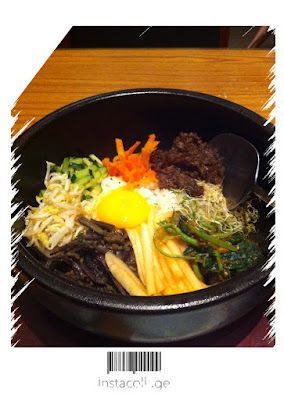Saya pesen bulgogi bimbap. Isinya nasi yang ditaruh di mangkuk panas dengan topping macam-macam sayuran (toge, wortel dan nggak tahu sayuran apa lagi), telur 3/4 matang dan beef bulgogi. Cara makannya, semua diaduk dan dikasih pasta gochujang. Tipikal restoran Korea, selain menu utama pasti akan disediain menu pelengkap gratis. Menu pelengkap yang saya dapet kimchi, asinan mangga, miso soup, kangkung dimasak pakai soy bean dan entah yang 1 nggak tahu namanya. Rasanya? Enak! Kenapa ya bisa ada makanan seenak itu?
Bibimbap (비빔밥, Korean pronunciation: [bibimbap],[1] sometimes anglicized bi bim bap or bi bim bop) is a signature Korean dish. The word literally means "mixed rice". Bibimbap is served as a bowl of warm white rice topped with namul (sautéed and seasoned vegetables) and gochujang (chili pepper paste), soy sauce, or doenjang, a fermented soybean paste. A raw or fried egg and sliced meat (usually beef) are common additions. The hot dish is stirred together thoroughly just before eating.[2]
In South Korea, Jeonju, Jinju, and Tongyeong are especially famous for their versions of bibimbap.[3] In 2011, it was listed at number 40 on the World's 50 most delicious foods readers' poll compiled by CNN Travel.[4]
The name bibimbap was adopted in the early 20th century. From the Joseon Period (1392–16th century) until the 20th century, Bibimbap was called goldongban, which means rice made by mixing various types of food. This dish was traditionally eaten on the eve of the lunar new year as the people at that time felt that they had to get rid of all of the leftover side dishes before the new year. The solution to this problem was to put all of the leftovers in a bowl of rice and to mix them together.[5] Bibimbap is also thought to have been eaten by farmers during farming season as it was the easiest way to make food for a large amount of people.[citation needed] Bibimbap, known as goldongban at that time, was served to the king usually as a lunch or an between-meal snack.[6]
Bibimbap is first mentioned in the Siuijeonseo, an anonymous cookbook from the late 19th century.[7][8] There its name is given as 부븸밥 (bubuimbap).[9] Some scholars assert that bibimbap originates from the traditional practice of mixing all the food offerings made at an ancestral rite (jesa) in a bowl before partaking in it, while the consensus on origins of the dish lies with a Japanese influence, brought to the Korean peninsula via trade routes with Japan. [10]
Since the late 20th century, bibimbap has become widespread in different countries, due to its convenience of preparation. It is also served on many airlines connecting to South Korea. (sumber: wikipedia)


No comments:
Post a Comment